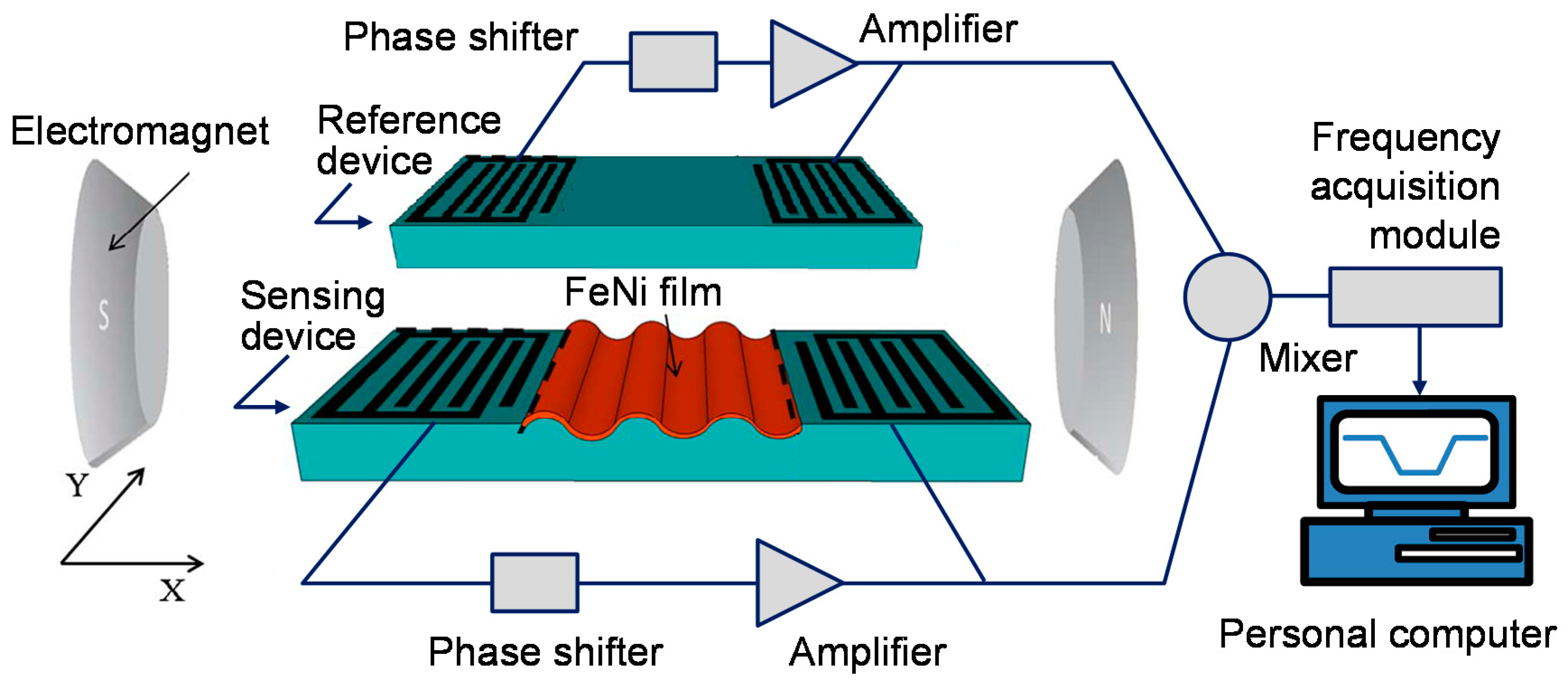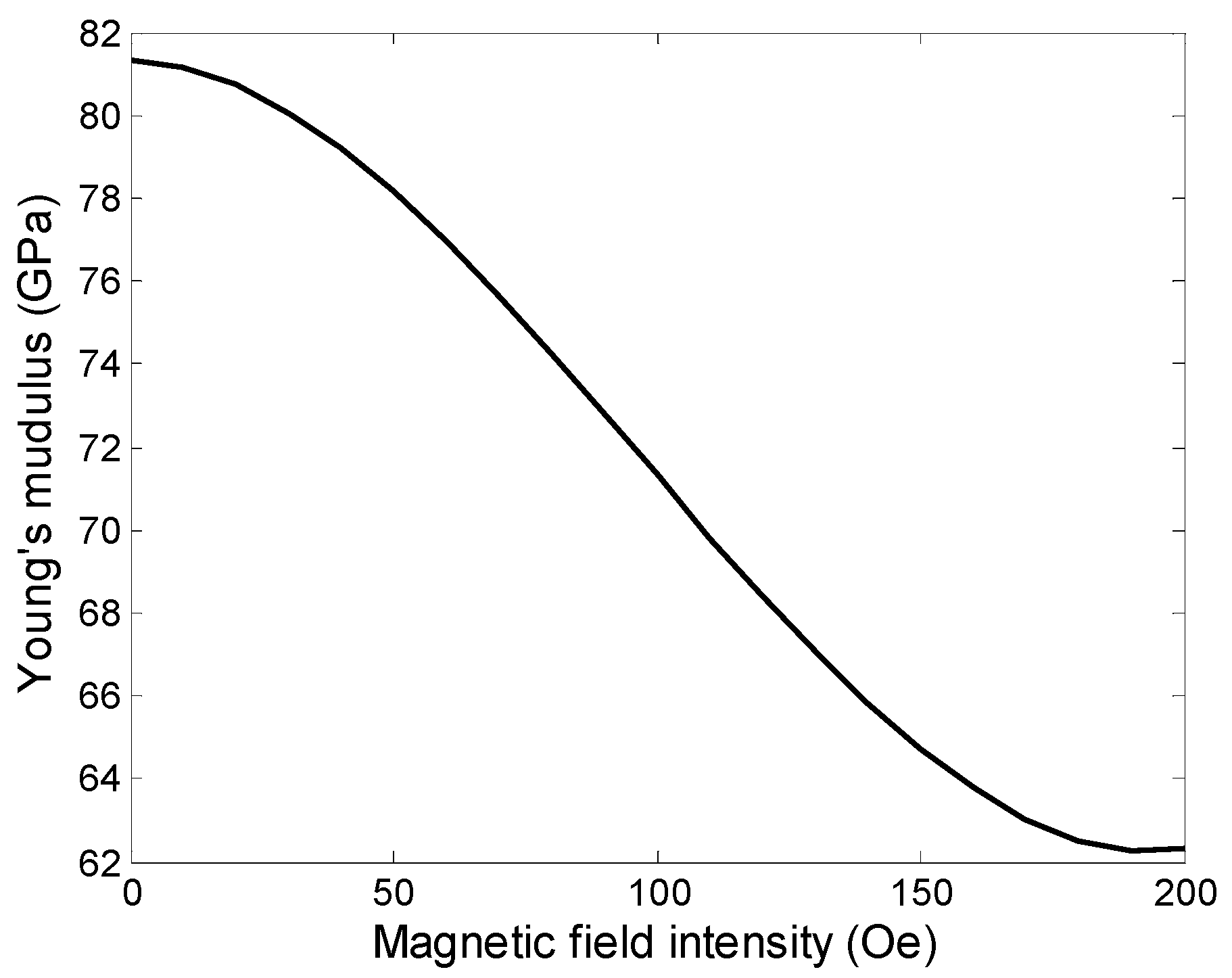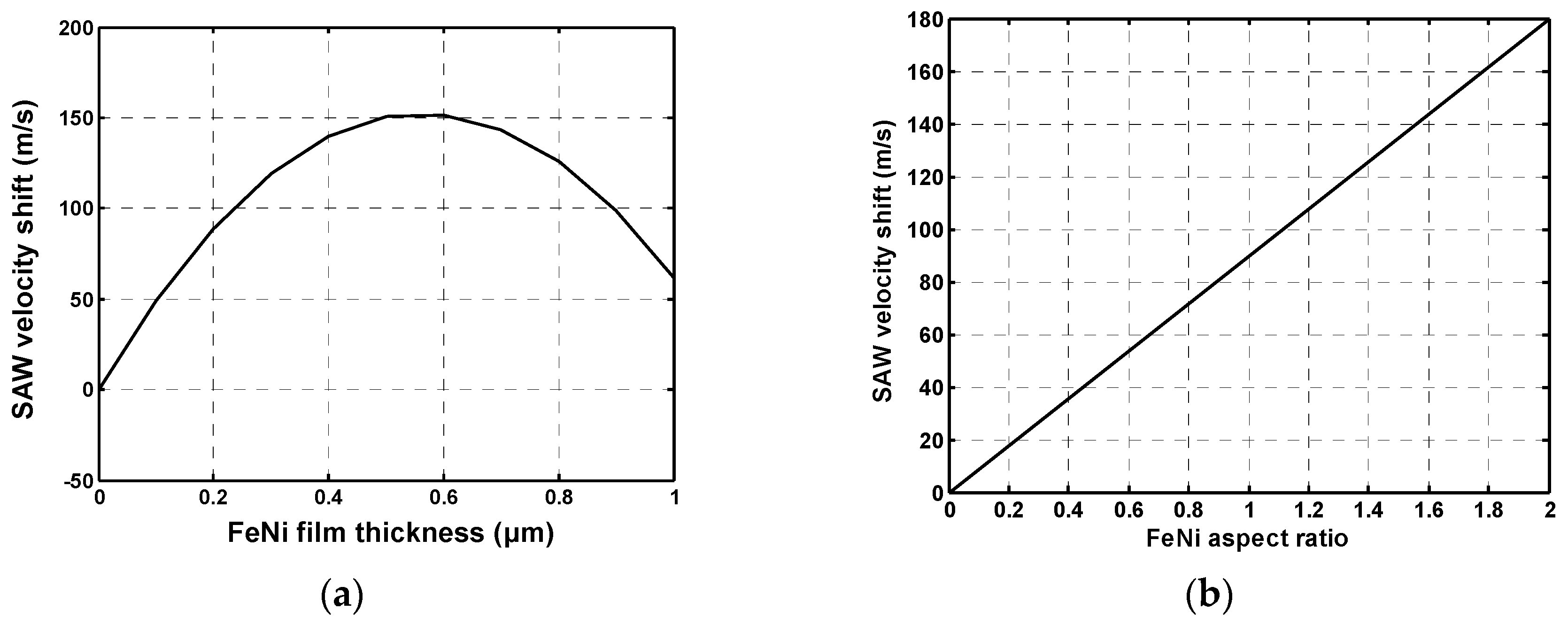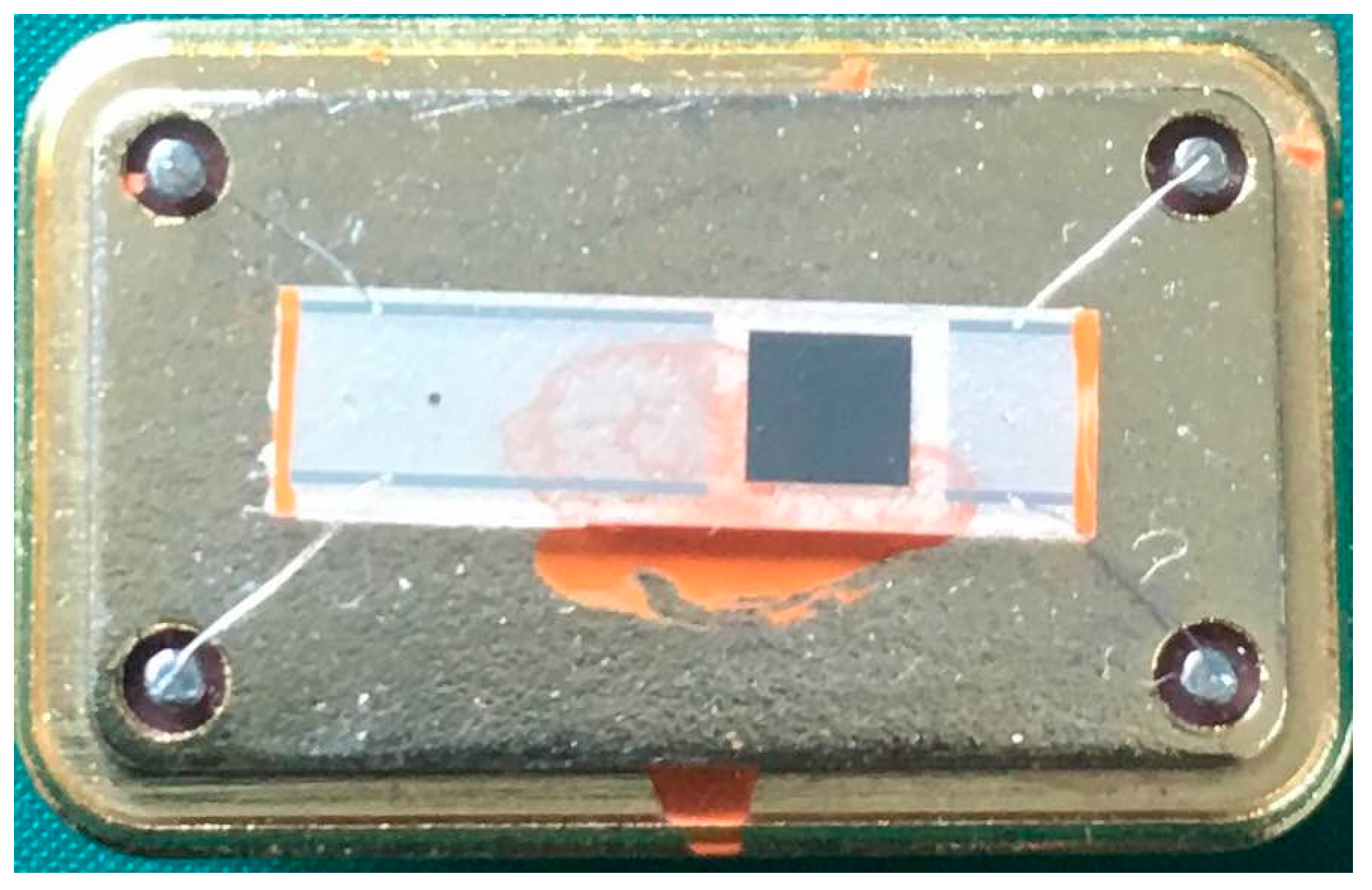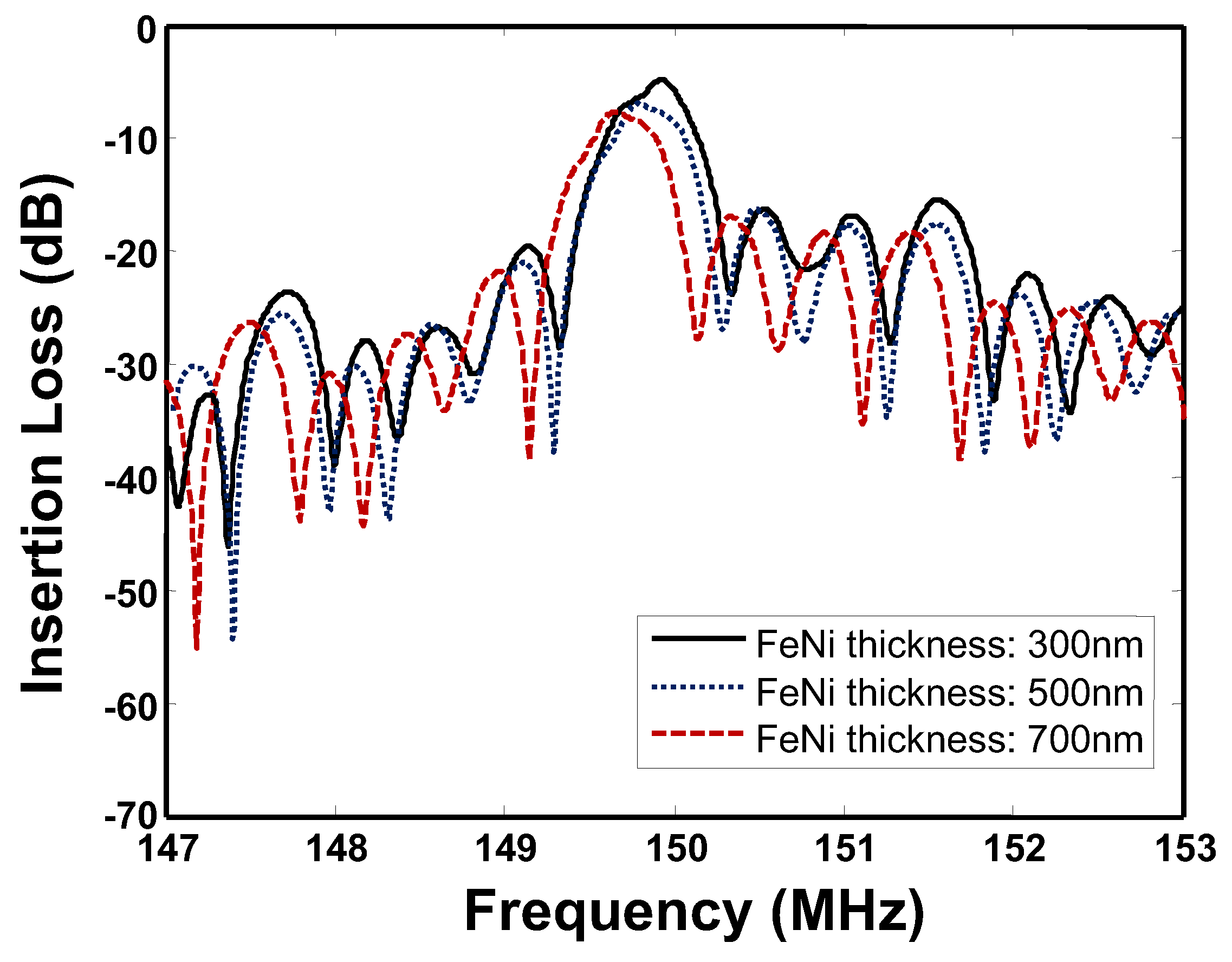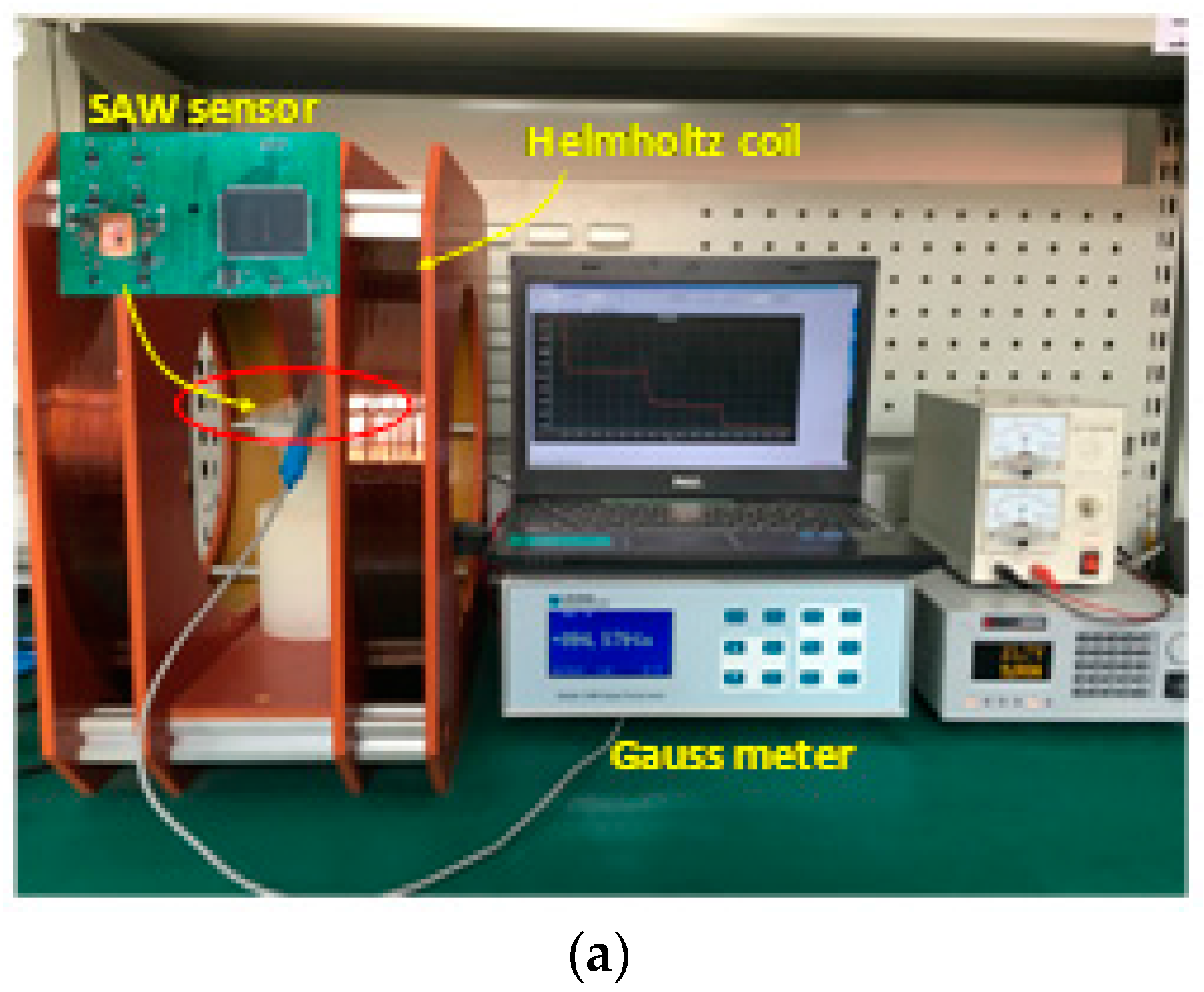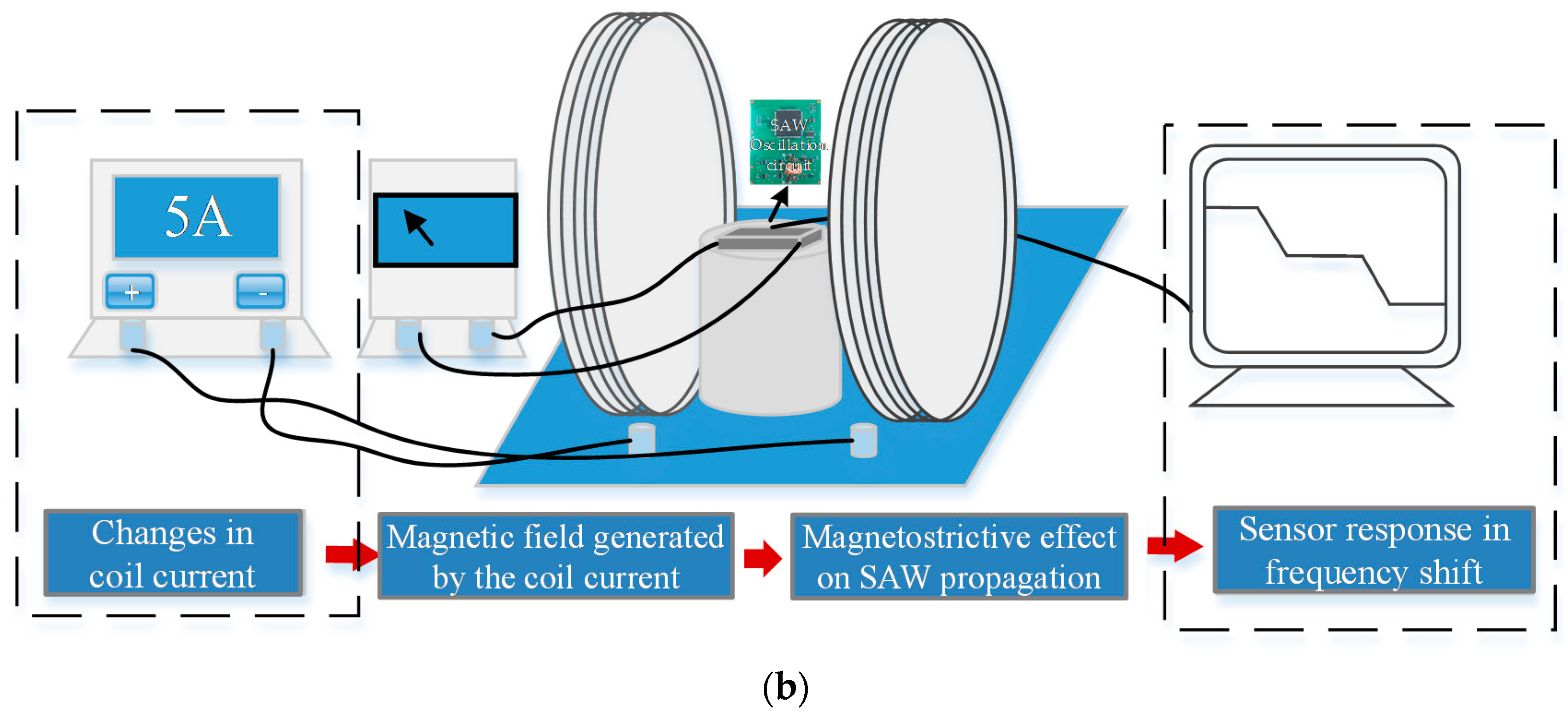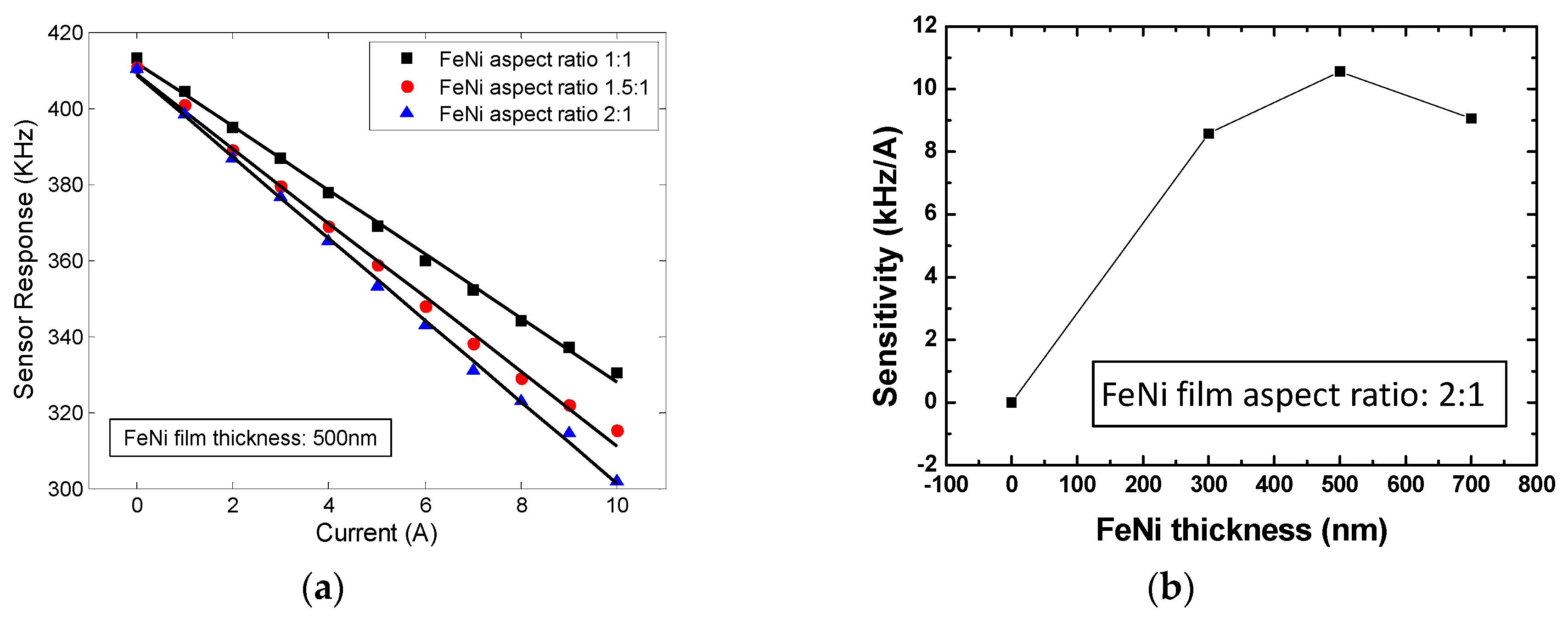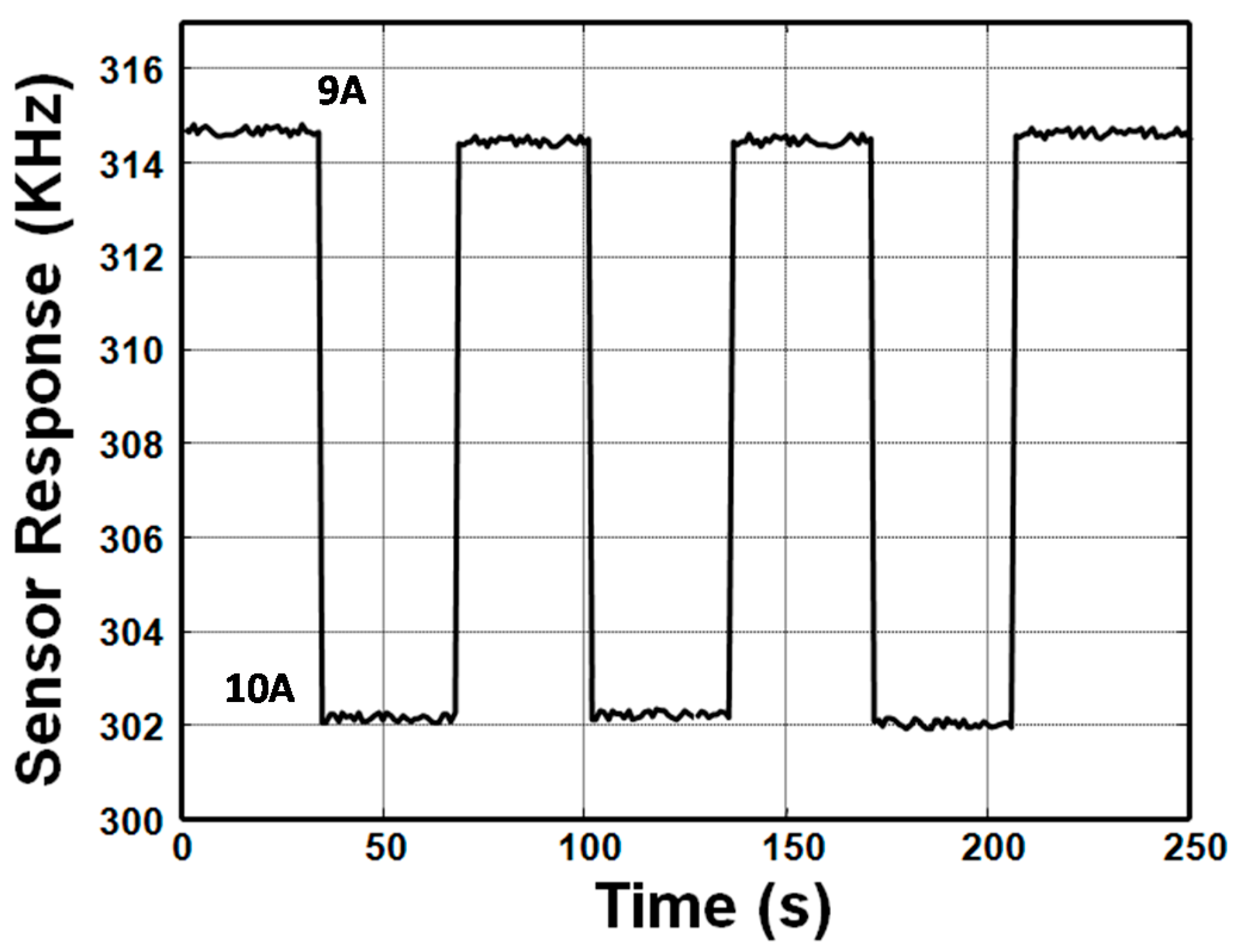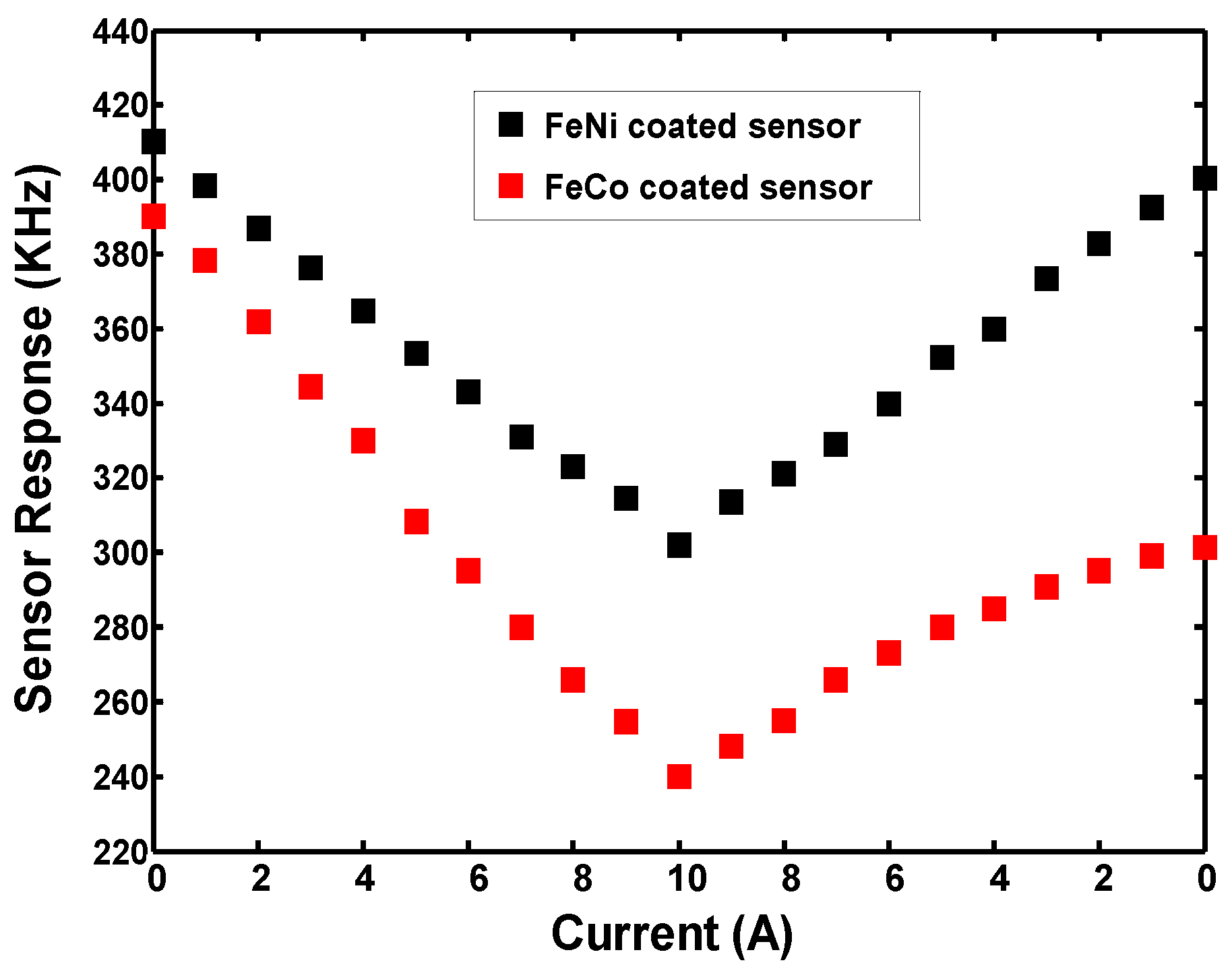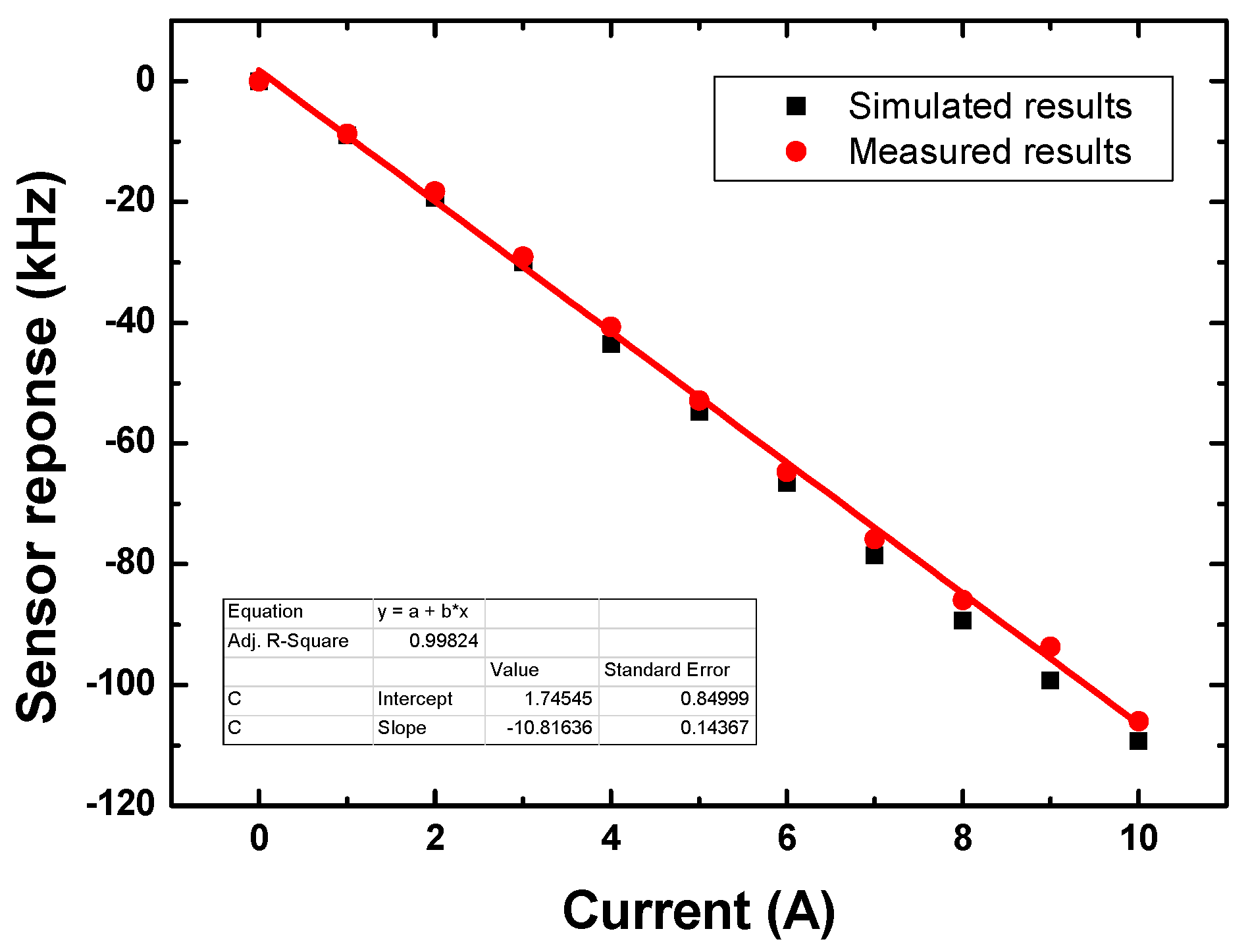1. Introduction
Surface acoustic wave (SAW)-based devices attracts increasing attention for various physical and chemical sensing because they offer some unique performances such as high sensitivity, excellent reproducibility, small size, simple structure, robustness, being passive (batteryless), and remotely queried (wireless). Many proven SAW-based sensors were developed for sensing gas species, temperature, force, torque, and so on [
1,
2,
3,
4,
5]. Recently, referring to the magnetostrictive thin film as the sensing material or magnetoresistor as the external loaded sensor, a new concept of SAW-based magnetic/current sensor were proposed, allowing possible features of fast response, high sensitivity, strong anti-interference, and small size. The functional magnetostrictive thin-film materials are favored and very promising for high-precision magnetic/current field measurement owing to their large magnetostrictive coefficient, high energy conversion efficiency, fast response and non-contact driving. Kodota et al. subsequently presented a new prototype of SAW magnetic sensor using interdigital transducers (IDTs) made by magnetostrictive Ni electrodes on a quartz substrate and wireless and passive measurement was offered. Obtained magnetic sensitivity was 730 Hz/mT [
6,
7]. Elhosni et al. proposed a similar SAW magnetic sensor with a magnetostrictive-piezoelectric layered structure of Ni/ZnO/IDT/LiNbO
3, and the corresponding finite element modeling (FEM) simulation was performed to predict the sensor performance [
8,
9]. Using the Galfenol thin film as the sensitive interface, a SAW magnetic field sensor was developed by Li et al. a maximum change of 0.64% in SAW velocity was obtained with a 500 nm Galfenol thick film, but not including further details about the experimental results [
10]. Zhou et al. addresses the experimental and theoretical investigations of SAW magnetic sensor structured by TbCo
2/FeCo/Y-cut LiNbO
3 [
11]. Just recently, a magnetostrictive FeCo-coated SAW magnetic/current sensor using the differential oscillation structure was proposed in our previous work, where high sensitivity of 16.6 KHz/A was obtained [
12].
As for the magnetoresistor loaded magnetic sensor, Hauser et al. developed a wirelessly interrogable micro-magnetic field sensor using the giant magneto-impedance (GMI) effect in a 30 μm diameter amorphous FeCoSiBNd wire of zero magnetostriction, and a SAW transponder devices, a relative signal sensitivity of 80 dB/T at low magnetic flux density B less than 30 mT, quick response, and a high temperature stability were obtained [
13]. Utilizing a reflective delay line pattern loaded a tri-layer GMI sensor, an autonomous magnetic field sensor was realized by Li et al. and a sensitivity of 0.34 dB/Oe are reported experimentally [
14,
15]. Also, Reindl et al. reported a dexterous design of the configuration of the SAW magnetic/current sensor loaded with magnetoresistor sensor, where wireless and passive measurement for current was realized [
16,
17], and the obtained current resolution is approximately 5% of full scale (−800~800 A).
Obviously, the magnetostrictive film coated SAW sensor exhibits simpler design, higher magnetic sensitivity and better temperature compensation in sensor structure over the magnetoresistor loaded sensor, and becomes the future research focus. Some magnetostrictive materials with larger magnetostrictive coefficient as FeCo, TbCo2 were advised as the sensitive coating, which produce higher magnetic sensitivity. However, due to the large magnetic remanence and hysteresis effect of these materials mentioned above, there occurs obvious asymmetry in sensor response at increasing and decreasing current, which degrades significantly the sensor performance.
Among the available magnetostrictive materials, the FeNi features very small variation of coercive field and narrow and steep magnetic hysteresis, and additionally, it has excellent rust resistance and better process ability over the FeCo film, which makes it very promising for magnetic/current sensing, and was employed as the sensitive materials in this contribution.
So, the first aim in this work is to perform the simulation on the sensor response by solving the coupled electromechanical field equation in layered structure considering the magnetostrictive effect and approach of effective constant [
12], and then to determine the optimal design parameters for FeNi coating preparation by analyzing the effect on sensor response from the film thickness and aspect ratio.
Then, a FeNi-coated SAW based current sensor was constructed, which was composed of a differential SAW delay line oscillator configuration, and magnetostrictive FeNi thin film deposited along the SAW propagation path of the sensing device. The scheme and working principle of the proposed sensor are depicted in
Figure 1. YZ-LiNbO
3 was utilized as the piezoelectric substrate, which provides larger electromechanical coupling coefficient (4.1%) to reduce the insertion loss of the SAW chip, and linear temperature coefficient of frequency (TCF) contributing to the temperature compensation by using the differential structure mentioned in
Figure 1. Additionally, the single phase unidirectional transducers (SPUDTs) with Al electrodes were used to structure the SAW device to reduce the insertion loss [
18,
19]. The FeNi thin film was then coated on the top surface of the sensing device by RF magnetron sputtering and overlay technique. Prior to FeNi coating, a 50 nm SiO
2 film was deposited on the piezoelectric substrate to provide a well protection on interdigital transducers (IDTs) in procedure of FeNi coating. The FeNi film produces magnetostrictive strain stimulated by the electromagnetic field, where the thickness, density and young’s modulus of the FeNi film are changed accordingly, and then the SAW propagation characteristic are modulated in the form of shift in SAW velocity. The applied electromagnetic field can be evaluated by using the corresponding differential oscillation frequency signal. Utilizing the Helmholtz coil system, the developed SAW sensor was characterized, and in comparison to FeCo coated sensor.
2. Simulation on the Sensor Response
Prior to sensor device development, the sensor response was simulated theoretically to extract the optimal design parameters.
In the simulation, the SAW sensor was simplified as a structure composed of a semi-infinite piezoelectric substrate with IDT pattern, a SiO
2 coating, and a magnetostrictive FeNi thin film as shown in
Figure 2. Also, the theoretical simulation is referring to the way of an analytical resolution of acoustic motion equations in layered structure considering the magnetostrictive effect described in [
12], so the influences of different parameters on sensor performances appear clearly. The corresponding coordinate system is shown in
Figure 2. Acoustic wave propagates along the
x1 axis on the
x1 −
x2 plane at
x3 = 0. All material parameters of the mediums are transformed into the coordinate system. Each material in the layered structure is defined by its physical parameters: stiffness constants (
cIijkl), piezoelectric constant (
ekij), permittivity constant (
εij), and density (
ρI) for LiNbO
3, stiffness constants ((
cIIijkl)) and density (
ρII) for SiO
2, Young’s modulus (
E) and density (
ρIII) for FeNi.
h1 and
h2 express the thicknesses of SiO
2 and FeNi, respectively. The corresponding physical parameters for piezoelectric substrate, SiO
2, and FeNi are listed in
Table 1 [
20]. The SAW velocity relating to the electromagnetic field intensity can be calculated by solving the elastic wave equations of each media utilizing corresponding boundary conditions. The following is the specific theoretical simulation.
It is well known that the constitutive equations in a piezoelectric medium are expressed as in [
21].
where
i,
j = 1, 2, 3,
K,
L = 1, 2, … 6,
,
and
Φ are the density, displacement and electric potential in YZ-LiNbO
3, respectively.
The field space of the frequency domain and the frequency slowness field (
s) can be characterized by Fourier transform pairs, hence, a general solution of the coupled wave Equation (1) was assumed in the slowness (
s) region as
where,
s is the SAW slowness, and defined by the reciprocal of the SAW velocity, α is the acoustic attenuation factor in
x3 direction.
Substituting Equation (2) into the coupling wave Equation (1), and the Christoffel equation of the piezoelectric substrate in the slowness field is obtained, which is a quadratic polynomial of
α, and expressed by
where,
αI is the characteristic root, and
AI1, 2, 3, 4 are undetermined constants, i.e., eigenvectors.
The necessary condition for the existence of the non-trivial solution in Christoffel equation is det(
Γ) = 0, and an eight degree equation about α
I was obtained.
Γ is the determinant of the coefficient matrix. To ensure the decrease of the acoustic displacement into the substrate, four roots of α
I with imaginary part more than zero were picked, that is, α
In (
n = 1, 2, 3, 4). Then, Substituting α
In into the Christoffel equation, a set of eigenvectors corresponding to each α
In are deduced. It is clear that only the linear superposition of the solutions as Equation (2) corresponding to α
In (
n = 1, 2, 3, 4) can satisfy the Christoffel equation and the boundary conditions. Thus, the integral solution was formed as the linear superposition of the wavelet solution, that is,
where
CIn (
n = 1, 2, 3, 4) is the weighted factor which determined by the boundary conditions.
Usually, the SiO
2 and FeNi can be considered as isotropic media, and their typical matrix representation of acoustic wave equations are defined by
So, the integral solution in acoustic equation of the isotropic SiO
2 film is assumed as
Then, substituting Equation (6) into the wave Equation (5), the corresponding Christoffel equation is obtained by
Similarly, the conditions for existence of non-trivial solution in Christoffel equation is that the determinant of the coefficient matrix (
Γ) should be zero, that is, det(
Γ) = 0. A six degree equation about α
I can be deduced. Since the thickness of the SiO
2 film is limited, the six roots of
(
p = 1, 2, …, 6) all satisfy the Christoffel equation, and the integral form of the displacement in the frequency slowness domain is expressed by
where
i = 1, 2, 3.
AiII is eigenvectors corresponding to
apII,
CpII (
p = 1, 2, …, 6) are the weighted coefficients, and determined by the boundary conditions.
The solution in FeNi thin film is similar to SiO
2. And the corresponding integral solution of the displacement in the frequency slowness domain of the FeCo film can be expressed as
where, the corresponding six eigen values and eigenvectors in FeNi film are expressed as
apIII and
ApIII (
p = 1, 2, 3, 4, 5, 6), and
CnIII (
n = 1, 2, 3, 4) are the weighted coefficients.
There is no free charge distribution in the region of 0 <
x3 <
h1,
h1 <
x3 <
h1 +
h2, and
h1 +
h2 <
x3, which are marked by
II,
III and
G, respectively. Then the potentials
ΦII,
ΦIII and
ΦG satisfying the Laplace equation
are introduced to meet the electrical boundary conditions, and the electric displacement components
D3 in the
x3 direction are determined in the corresponding regions.
ΦII,
ΦIII,
ΦG,
,
and
in the frequency slowness field are expressed by
where,
εII,
εIII and
ε0 are the dielectric constant of the SiO
2 layer, FeNi layer and the air dielectric constant, respectively,
ε0 = 8.854 × 10
−12 (F/m).
The boundary conditions for each surface of the layered media structure shown in
Figure 2 are described as below. Firstly, the stress, displacement, and electric potential are continuous at
x3 = 0 and
x3 =
h1, that is,
The normal component of the stress at
x3 =
h1 +
h2 is considered as zero, and the corresponding displacement and electric potential are continuous as
To sum up, there are 21 undetermined unknowns in the Christoffel equation expressed by , , , , , , and . It means that there are 21 equations to determine the unknowns. To simply the calculation, the approach of effective dielectric constant was used.
The effective dielectric constant at the boundary of
x3 = 0 is defined by [
22]
Accordingly, the εs(s) value corresponding different slowness s can be deduced, and also the surface effective dielectric constant εs(s) curve can be pictured. Usually, εs(s) is a complex number. The slowness sm corresponding to the maximum value of the real part shows the case of metallization at x3 = 0. While the slowness sf corresponding to the zero-crossing of the real part shows the free surface at x3 = 0. According to the reciprocal relationship, the corresponding SAW velocity in metalized surface vm, and velocity in free surface, vf, at x3 = 0, can be obtained, respectively.
Usually, the magnetostriction of FeNi film will be changed by its aspect ratio [
23],
where
β and
β0 are the perturbed and unperturbed magnetostriction of the FeNi film, respectively, and
p =
l/
w is the aspect ratio,
l and
w are the length and width of FeNi film, respectively.
kp is the correlation coefficient, and is set to 7.13 × 10
−4 [
23].
Owing to the magnetostrictive nature, the FeNi film would be magnetized under the electromagnetic field, resulting in the changes in FeNi film thickness
h and density
ρ, which can be written by
where
m is the mass of the FeNi film,
a0,
b0,
h2 are the initial length, width and thickness of unperturbed FeNi, respectively, and obviously
m =
ρIII × (
a0 ×
b0 ×
h2).
Moreover, the young’s modulus (
E) of the FeNi will also be modulated by the electromagnetic field intensity (
H), and can be taken experimentally by using the laser resonance method [
24]. Correspondingly, the elastic coefficient of the FeNi will also be expressed as
where the Poissoncoefficient of FeNi,
uF, was considered as constants irrelevant to the electromagnetic field, and it was set to 0.3.
Hence, using above equations and the measured relationship between the young’s modulus of FeNi and the magnetic field (
Figure 3), the shift in SAW velocity shift depending on the applied electromagnetic field can be calculated. Also, considering the relationship between the electromagnetic field intensity (
H) and current (A) described by the Biot-Savart law [
25],
where,
μ0 denotes the permeability in vacuum.
l expresses the distance between the sensor chip and wires, and is set to 1 cm in this calculation, the sensitivity in current sensing can be evaluated theoretically. Furthermore, the influence of FeNi thickness and aspect ratio (
a0/
b0) on sensor response can be analyzed using the physical parameters listed in
Table 1. The sensor response was defined as the difference between the perturbed and unperturbed SAW velocity. The given electromagnetic field intensity and working frequency of sensor in the calculation are set to 200 Oe and 150 MHz. Nonlinear relationship was observed between the sensor response and FeNi thickness, as shown in
Figure 4a. The sensor response increases rapidly with increasing the FeNi thickness up to ~0.5 μm and then reaches the max response value. Hence, the optimal value in FeNi thickness is advised to ~500 nm. Additionally, the effect of the aspect ratio of the FeNi on sensor response was also analyzed as shown in
Figure 4b. With increasing the aspect ratio (1:1 to 2:1), larger sensor response was observed. However, lager aspect ratio will lengthen SAW propagation path, resulting in increase of the acoustic propagation attenuation. So, in our opinion, proper increase in aspect ratio of FeNi film is an effective way to improve the sensor sensitivity.
Then, referring to the Biot-Savart law mentioned Equation (16) and velocity-frequency relationship of Δv/v
s = Δf/f
0 (Δv and Δf are the shift in SAW velocity v
s and sensor frequency f
0), the current sensitivity of the 150 MHz SAW sensor coated with 500 nm FeNi (aspect ratio is set to 2:1) was calculated as shown in
Figure 5, and sensitivity of ~11 KHz/A was expected.
